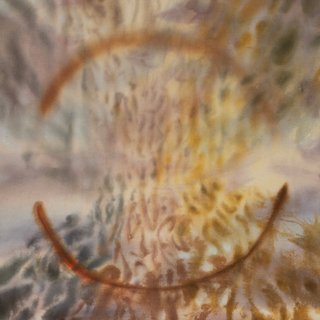There’s worlds to discover among the landscapes of Thought Makes Music. The more you give it, the more it gives you.
The debut full-length record by Sydney artist Gigi De Lacy is a triumph of concept and execution. An sonic turn from her work as lead singer of Sydney punk-philosophers Optic Nerve, its title is a knowing wink. Grouping dance music into genres has always been, to an extent, a helpless exercise, and IDM is one of its more cringe-inducing sub-categorisations. Ironically, the term has historically been laughed off by most of the luminary artists in its canon. To say that electronic music pre-IDM was, in some way, un-or-less intelligent is an obviously unserious assessment. Particularly as many pioneering IDM musicians were simply mutating forms of already-existing dance music.
What’s more, the coldness of the term ‘Intelligent Dance Music’ betrays the endless possibilities of the genre: how hyper-specific detail can further that sense of deep feeling that electronic music provides. Yes, the thought does make music, but it’s not an abstract, unfeeling exercise; it's a transubstantiation of those brain synapses into textured rhythm and movement.
It’s this movement that brings Thought Makes Music to life. Its breakbeat and dubstep charged pulse barrells constantly towards polyrhythmic infinity - inherently irregular, like all living heartbeats are. Thus the record refracts back the promise of its title – thought has made music, but this music also makes thought, as the listener applies their own synesthesic image to its living, breathing terrains. The beautiful kaleidoscope of ‘21, 22, 23’ could be the glistening glare of direct summer sunlight, the flickering breakbeats of ‘knots’ the fluttering of moth’s wings, slowly hovering closer, more daringly, towards a flame.
This dialectical understanding maps more specifically to the actual genesis of Thought Makes Music’s title, a quote by postcolonial philosopher, poet and critic Edouard Glissant. For gi, Glissant’s thesis of noise as a mode of expression that “disorder our relations with the world around us” articulates an recognition of sound as something always with the ability to disrupt.
Many of the sounds on Thought Makes Music come from a video of gi arranging a bouquet of weeds in a water bottle, “commemorating getting a really expensive pair of shoes broken by some c*nt that pulled a knife on me and (tried) to beat me up while walking alone.” Feedback loops are deliberately prodded by gi sampling the video, blowing it up so it spikes and clips. She asks, what new possibilities come from embracing the artefacts of noise, what hidden worlds are latent, waiting to be discovered in its invisible waves of sound? It’s an ideology of sound rooted in the real material reality of the world – a world that is not perfect nor docile, but instead messy and challenging. A world primed with the potentiality of resistance, dominos waiting to tumble with just the right push.
Thought Makes Music is an essentially radical yet un-hubristic understanding of music, unsurprising, given gi’s deep commitment to community and DIY ethoses in Optic Nerve. Although designed to transmit from and give back to the world that created it, Thought Makes Music is gi’s singular creation – this brilliance came from someone’s thoughts, their mind. The world around us can offer us so much inspiration and strength – but that power lies undoubtedly within us too.
Words by Lindsay Riley
